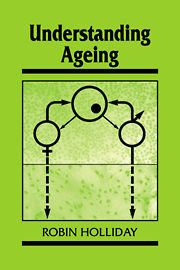Book contents
- Frontmatter
- Contents
- Preface
- Author's note
- Acknowledgements
- 1 Introduction
- 2 The evolved anatomical and physiological design of mammals
- 3 Maintenance of the adult organism
- 4 Theories of ageing
- 5 Cellular ageing
- 6 Genetic programmes for ageing
- 7 The evolution of longevity
- 8 Human disease and ageing
- 9 A better understanding of ageing
- Notes
- References
- Author index
- Subject index
8 - Human disease and ageing
Published online by Cambridge University Press: 31 March 2010
- Frontmatter
- Contents
- Preface
- Author's note
- Acknowledgements
- 1 Introduction
- 2 The evolved anatomical and physiological design of mammals
- 3 Maintenance of the adult organism
- 4 Theories of ageing
- 5 Cellular ageing
- 6 Genetic programmes for ageing
- 7 The evolution of longevity
- 8 Human disease and ageing
- 9 A better understanding of ageing
- Notes
- References
- Author index
- Subject index
Summary
Experimental gerontology is the study of the ageing of animals or plants, or of their cells in culture. In the many reviews and books discussing this field, very little, if any, attention is paid to the many human pathological changes that occur during ageing. Yet this pathology comprises a vast resource of material that is very relevant to any understanding of ageing. Since the serious initiation of anatomical medicine in the 16th and 17th centuries, information has been collected about pathological changes in the human body, some of which occur predominantly in old individuals. With the introduction of the use of the microscope and the realisation that organs and tissues are made up of cells, the science of histology made possible much more detailed descriptions of pathological changes. In more recent times, the electron microscope and biochemical analysis provided yet more information, and to this must now be added the extensive molecular studies that are being applied in more and more contexts.
For the most part this material is documented in specialised journals that deal with different organ or tissue systems. The total information is vast, and certainly enormously greater than the whole gerontological literature. Much may not be relevant to an understanding of ageing, but because so many pathological changes are age-related, a considerable proportion is not only relevant, but also provides very important insight into the cell, tissue and body changes that occur in human ageing, and into mammalian ageing in general.
- Type
- Chapter
- Information
- Understanding Ageing , pp. 122 - 138Publisher: Cambridge University PressPrint publication year: 1995

